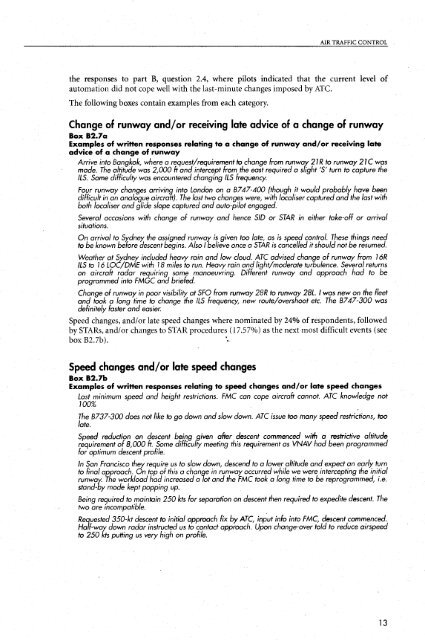Advanced Technology Aircraft Safety Survey Report - Australian ...
Advanced Technology Aircraft Safety Survey Report - Australian ...
Advanced Technology Aircraft Safety Survey Report - Australian ...
You also want an ePaper? Increase the reach of your titles
YUMPU automatically turns print PDFs into web optimized ePapers that Google loves.
AIR TRAFFIC CONTROL<br />
the responses to part B, question 2.4, where pilots indicated that the current level of<br />
automation did not cope well with the last-minute changes imposed by ATC.<br />
The following boxes contain examples from each category.<br />
Change of runway and/or receiving late advice of a change of runway<br />
Box B2.7a<br />
Examples of written responses relating to a change of runway and/or receiving late<br />
advice of a change of runway<br />
Arrive into Bangkok, where a request/requirement to change from runwa 2 I R to runway 2 7 C was<br />
made. The altitude was 2,000 ft and intercept from the east required a s r ight 'S' turn to capture the<br />
ILS. Some difficulty was encountered changing 11s frequency.<br />
Four runway changes arrivin into London on a B747-400 (though it would probabl have been<br />
difficult in an analogue aircra a ). The last two changes were, with localiser captured an cr the last with<br />
both localiser and glide slope captured and auto-pilot engaged.<br />
Several occasions with change of runway and hence SID or STAR in either take-off or arrival<br />
situations.<br />
On arrival to Sydney the assigned runway is given too late, as is speed control. These things need<br />
to be known before descent begins. Also I believe once a STAR is cancelled it should not be resumed.<br />
Weather at S dney included heavy rain and low cloud. ATC advised chan e of runway from 16R<br />
11s to I6 lOCY/DME with I8 miles to run. Heavy rain and light/moderate tur ulence. Several returns<br />
on aircraft radar requiring some manoeuvring. Different runway and approach had to be<br />
programmed into FMGC and briefed.<br />
Change of runway in poor visibility at SFO from runway 28R to runway 281. I was new on the fleet<br />
and took a long time to change the /IS frequency, new route/overshoot etc. The 6747-300 was<br />
definitely faster and easier.<br />
Speed changes, and/or late speed changes where nominated by 24% of respondents, followed<br />
by STARS, and/or changes to STAR procedures ( 17.57%) as the next most difficult events (see<br />
box B2.7b). L<br />
Speed changes and/or late speed changes<br />
Box B2.7b<br />
Examples of written responses relating to speed changes and/or late speed changes<br />
last minimum speed and height restrictions. FMC can cope aircraft cannot. ATC knowledge not<br />
J 00%<br />
The B737-300 does not like to go down and slow down. ATC issue too many speed restrictions, too<br />
late.<br />
Speed reduction on descent being given after descent commenced with a restrictive altitude<br />
requirement of 8,000 ft. Some difficulty meeting this requirement as VNAV had been programmed<br />
for optimum descent profile.<br />
In San Francisco they require us to slow down, descend to a lower altitude and expect an early turn<br />
roach. On top of this a chan e in runway occurred while we were intercepting the initial<br />
workload had increased a 7 ot and the FMC took a long time to be reprogrammed, ;.e.<br />
kept popping up.<br />
Being required to maintain 250 kts for separation on descent then required to expedite descent. The<br />
two are incompatible.<br />
descent to initial approach fix by ATC, input info into FMC, descent commenced.<br />
radar instructed us to contact approach. Upon change-over told to reduce airspeed<br />
us very high on profile.<br />
13
















